Nursing And Case Study Analysis Report
VerifiedAdded on 2022/08/15
|8
|2351
|20
AI Summary
Contribute Materials
Your contribution can guide someone’s learning journey. Share your
documents today.
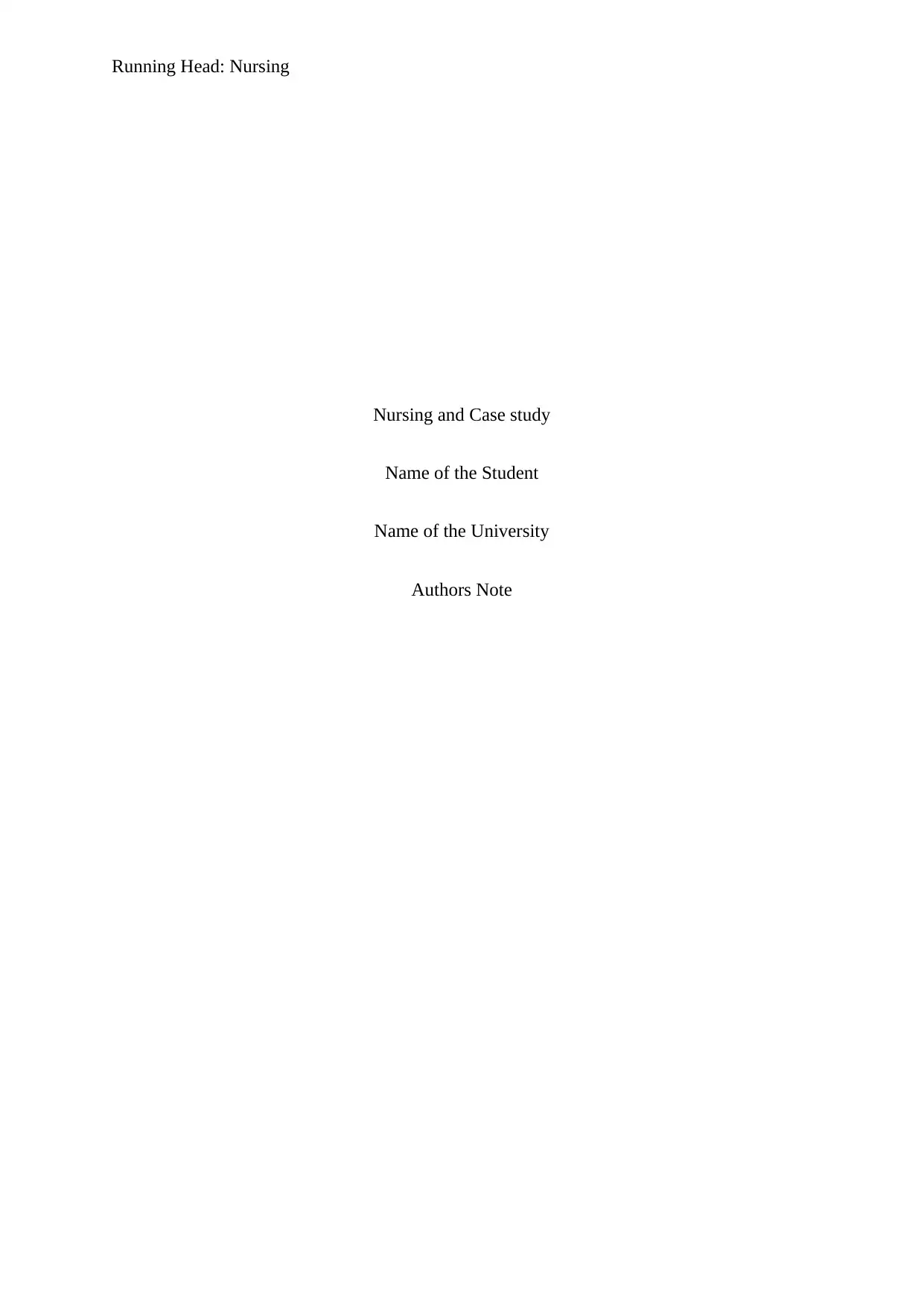
Running Head: Nursing
Nursing and Case study
Name of the Student
Name of the University
Authors Note
Nursing and Case study
Name of the Student
Name of the University
Authors Note
Secure Best Marks with AI Grader
Need help grading? Try our AI Grader for instant feedback on your assignments.
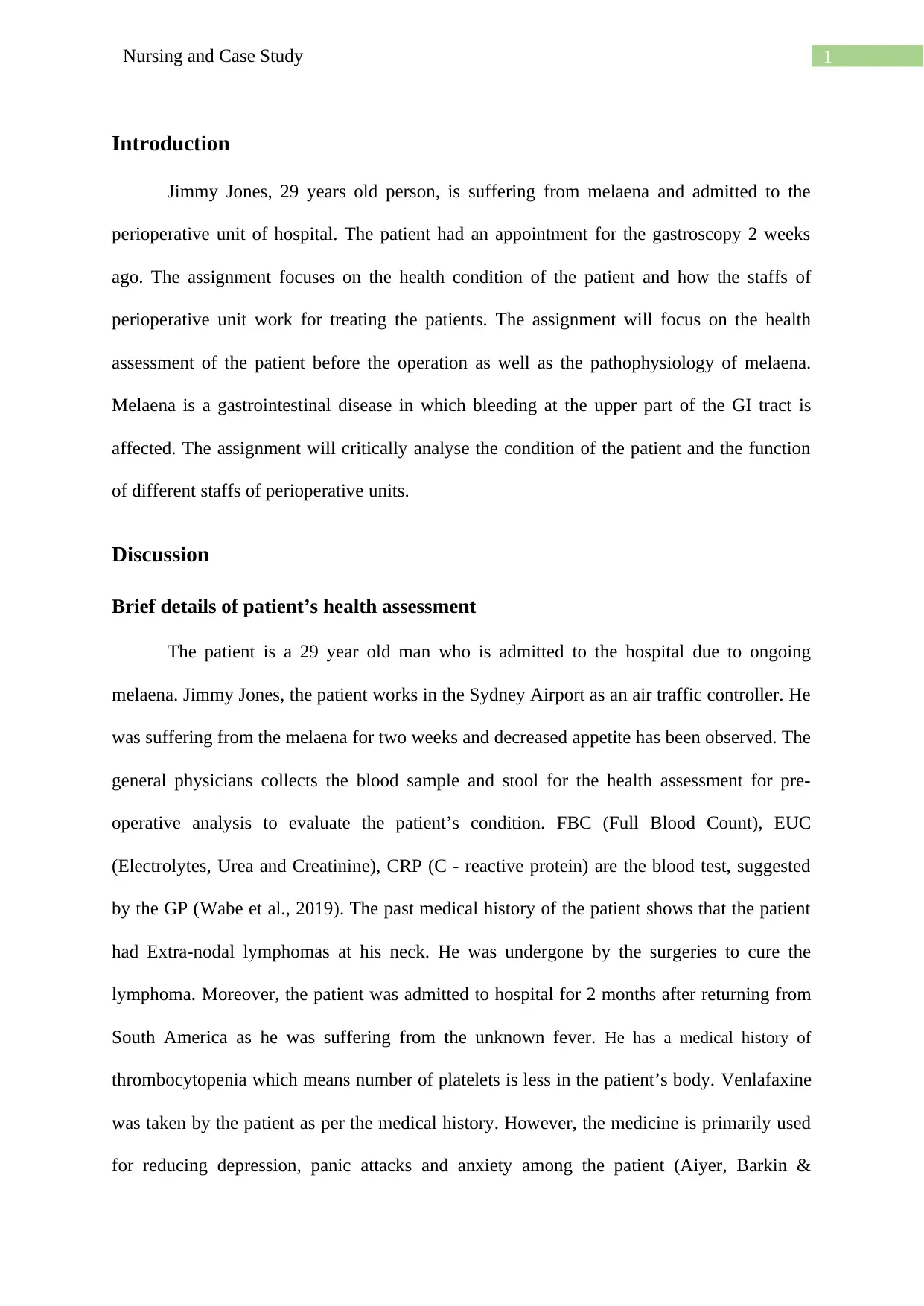
1Nursing and Case Study
Introduction
Jimmy Jones, 29 years old person, is suffering from melaena and admitted to the
perioperative unit of hospital. The patient had an appointment for the gastroscopy 2 weeks
ago. The assignment focuses on the health condition of the patient and how the staffs of
perioperative unit work for treating the patients. The assignment will focus on the health
assessment of the patient before the operation as well as the pathophysiology of melaena.
Melaena is a gastrointestinal disease in which bleeding at the upper part of the GI tract is
affected. The assignment will critically analyse the condition of the patient and the function
of different staffs of perioperative units.
Discussion
Brief details of patient’s health assessment
The patient is a 29 year old man who is admitted to the hospital due to ongoing
melaena. Jimmy Jones, the patient works in the Sydney Airport as an air traffic controller. He
was suffering from the melaena for two weeks and decreased appetite has been observed. The
general physicians collects the blood sample and stool for the health assessment for pre-
operative analysis to evaluate the patient’s condition. FBC (Full Blood Count), EUC
(Electrolytes, Urea and Creatinine), CRP (C - reactive protein) are the blood test, suggested
by the GP (Wabe et al., 2019). The past medical history of the patient shows that the patient
had Extra-nodal lymphomas at his neck. He was undergone by the surgeries to cure the
lymphoma. Moreover, the patient was admitted to hospital for 2 months after returning from
South America as he was suffering from the unknown fever. He has a medical history of
thrombocytopenia which means number of platelets is less in the patient’s body. Venlafaxine
was taken by the patient as per the medical history. However, the medicine is primarily used
for reducing depression, panic attacks and anxiety among the patient (Aiyer, Barkin &
Introduction
Jimmy Jones, 29 years old person, is suffering from melaena and admitted to the
perioperative unit of hospital. The patient had an appointment for the gastroscopy 2 weeks
ago. The assignment focuses on the health condition of the patient and how the staffs of
perioperative unit work for treating the patients. The assignment will focus on the health
assessment of the patient before the operation as well as the pathophysiology of melaena.
Melaena is a gastrointestinal disease in which bleeding at the upper part of the GI tract is
affected. The assignment will critically analyse the condition of the patient and the function
of different staffs of perioperative units.
Discussion
Brief details of patient’s health assessment
The patient is a 29 year old man who is admitted to the hospital due to ongoing
melaena. Jimmy Jones, the patient works in the Sydney Airport as an air traffic controller. He
was suffering from the melaena for two weeks and decreased appetite has been observed. The
general physicians collects the blood sample and stool for the health assessment for pre-
operative analysis to evaluate the patient’s condition. FBC (Full Blood Count), EUC
(Electrolytes, Urea and Creatinine), CRP (C - reactive protein) are the blood test, suggested
by the GP (Wabe et al., 2019). The past medical history of the patient shows that the patient
had Extra-nodal lymphomas at his neck. He was undergone by the surgeries to cure the
lymphoma. Moreover, the patient was admitted to hospital for 2 months after returning from
South America as he was suffering from the unknown fever. He has a medical history of
thrombocytopenia which means number of platelets is less in the patient’s body. Venlafaxine
was taken by the patient as per the medical history. However, the medicine is primarily used
for reducing depression, panic attacks and anxiety among the patient (Aiyer, Barkin &
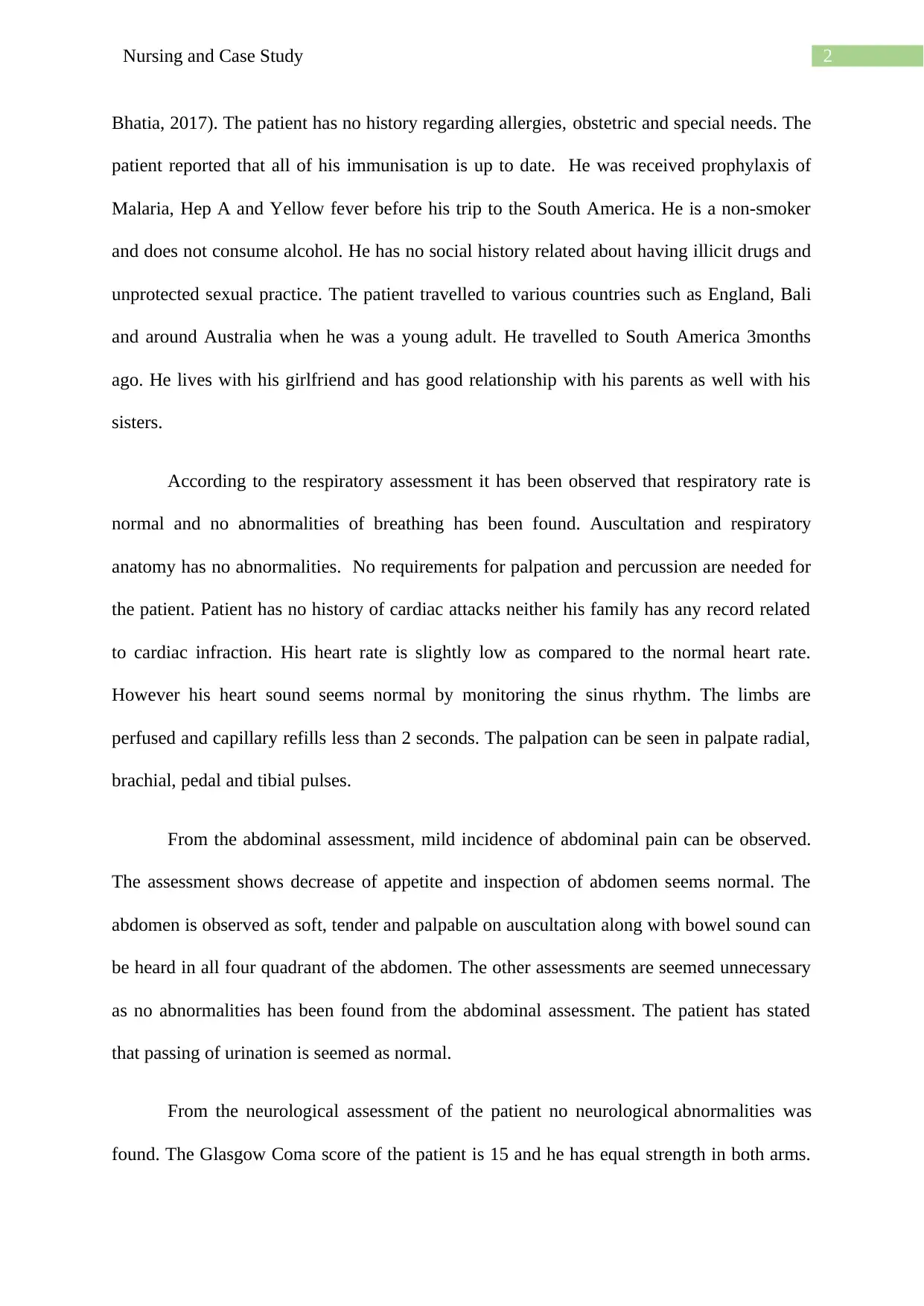
2Nursing and Case Study
Bhatia, 2017). The patient has no history regarding allergies, obstetric and special needs. The
patient reported that all of his immunisation is up to date. He was received prophylaxis of
Malaria, Hep A and Yellow fever before his trip to the South America. He is a non-smoker
and does not consume alcohol. He has no social history related about having illicit drugs and
unprotected sexual practice. The patient travelled to various countries such as England, Bali
and around Australia when he was a young adult. He travelled to South America 3months
ago. He lives with his girlfriend and has good relationship with his parents as well with his
sisters.
According to the respiratory assessment it has been observed that respiratory rate is
normal and no abnormalities of breathing has been found. Auscultation and respiratory
anatomy has no abnormalities. No requirements for palpation and percussion are needed for
the patient. Patient has no history of cardiac attacks neither his family has any record related
to cardiac infraction. His heart rate is slightly low as compared to the normal heart rate.
However his heart sound seems normal by monitoring the sinus rhythm. The limbs are
perfused and capillary refills less than 2 seconds. The palpation can be seen in palpate radial,
brachial, pedal and tibial pulses.
From the abdominal assessment, mild incidence of abdominal pain can be observed.
The assessment shows decrease of appetite and inspection of abdomen seems normal. The
abdomen is observed as soft, tender and palpable on auscultation along with bowel sound can
be heard in all four quadrant of the abdomen. The other assessments are seemed unnecessary
as no abnormalities has been found from the abdominal assessment. The patient has stated
that passing of urination is seemed as normal.
From the neurological assessment of the patient no neurological abnormalities was
found. The Glasgow Coma score of the patient is 15 and he has equal strength in both arms.
Bhatia, 2017). The patient has no history regarding allergies, obstetric and special needs. The
patient reported that all of his immunisation is up to date. He was received prophylaxis of
Malaria, Hep A and Yellow fever before his trip to the South America. He is a non-smoker
and does not consume alcohol. He has no social history related about having illicit drugs and
unprotected sexual practice. The patient travelled to various countries such as England, Bali
and around Australia when he was a young adult. He travelled to South America 3months
ago. He lives with his girlfriend and has good relationship with his parents as well with his
sisters.
According to the respiratory assessment it has been observed that respiratory rate is
normal and no abnormalities of breathing has been found. Auscultation and respiratory
anatomy has no abnormalities. No requirements for palpation and percussion are needed for
the patient. Patient has no history of cardiac attacks neither his family has any record related
to cardiac infraction. His heart rate is slightly low as compared to the normal heart rate.
However his heart sound seems normal by monitoring the sinus rhythm. The limbs are
perfused and capillary refills less than 2 seconds. The palpation can be seen in palpate radial,
brachial, pedal and tibial pulses.
From the abdominal assessment, mild incidence of abdominal pain can be observed.
The assessment shows decrease of appetite and inspection of abdomen seems normal. The
abdomen is observed as soft, tender and palpable on auscultation along with bowel sound can
be heard in all four quadrant of the abdomen. The other assessments are seemed unnecessary
as no abnormalities has been found from the abdominal assessment. The patient has stated
that passing of urination is seemed as normal.
From the neurological assessment of the patient no neurological abnormalities was
found. The Glasgow Coma score of the patient is 15 and he has equal strength in both arms.
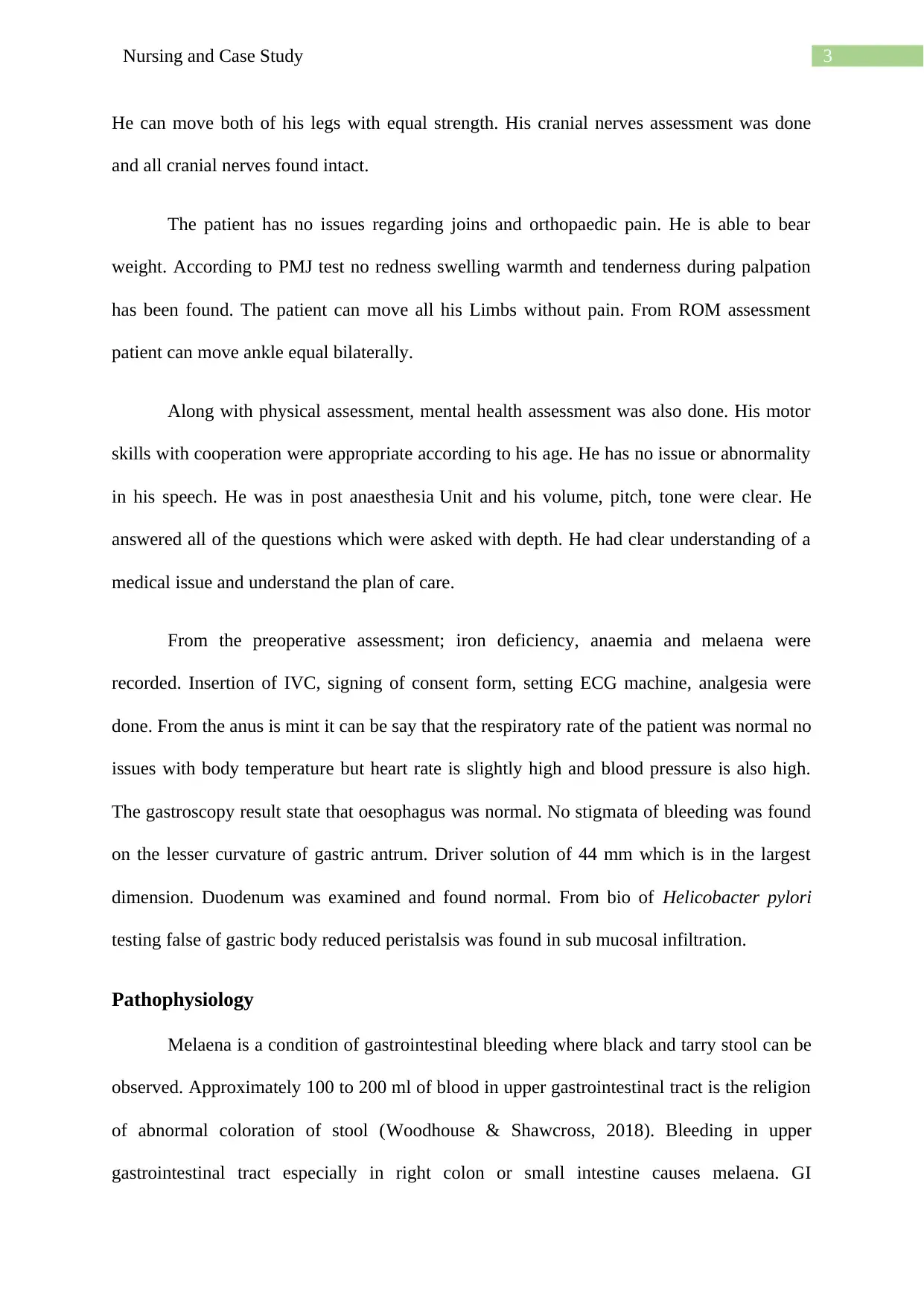
3Nursing and Case Study
He can move both of his legs with equal strength. His cranial nerves assessment was done
and all cranial nerves found intact.
The patient has no issues regarding joins and orthopaedic pain. He is able to bear
weight. According to PMJ test no redness swelling warmth and tenderness during palpation
has been found. The patient can move all his Limbs without pain. From ROM assessment
patient can move ankle equal bilaterally.
Along with physical assessment, mental health assessment was also done. His motor
skills with cooperation were appropriate according to his age. He has no issue or abnormality
in his speech. He was in post anaesthesia Unit and his volume, pitch, tone were clear. He
answered all of the questions which were asked with depth. He had clear understanding of a
medical issue and understand the plan of care.
From the preoperative assessment; iron deficiency, anaemia and melaena were
recorded. Insertion of IVC, signing of consent form, setting ECG machine, analgesia were
done. From the anus is mint it can be say that the respiratory rate of the patient was normal no
issues with body temperature but heart rate is slightly high and blood pressure is also high.
The gastroscopy result state that oesophagus was normal. No stigmata of bleeding was found
on the lesser curvature of gastric antrum. Driver solution of 44 mm which is in the largest
dimension. Duodenum was examined and found normal. From bio of Helicobacter pylori
testing false of gastric body reduced peristalsis was found in sub mucosal infiltration.
Pathophysiology
Melaena is a condition of gastrointestinal bleeding where black and tarry stool can be
observed. Approximately 100 to 200 ml of blood in upper gastrointestinal tract is the religion
of abnormal coloration of stool (Woodhouse & Shawcross, 2018). Bleeding in upper
gastrointestinal tract especially in right colon or small intestine causes melaena. GI
He can move both of his legs with equal strength. His cranial nerves assessment was done
and all cranial nerves found intact.
The patient has no issues regarding joins and orthopaedic pain. He is able to bear
weight. According to PMJ test no redness swelling warmth and tenderness during palpation
has been found. The patient can move all his Limbs without pain. From ROM assessment
patient can move ankle equal bilaterally.
Along with physical assessment, mental health assessment was also done. His motor
skills with cooperation were appropriate according to his age. He has no issue or abnormality
in his speech. He was in post anaesthesia Unit and his volume, pitch, tone were clear. He
answered all of the questions which were asked with depth. He had clear understanding of a
medical issue and understand the plan of care.
From the preoperative assessment; iron deficiency, anaemia and melaena were
recorded. Insertion of IVC, signing of consent form, setting ECG machine, analgesia were
done. From the anus is mint it can be say that the respiratory rate of the patient was normal no
issues with body temperature but heart rate is slightly high and blood pressure is also high.
The gastroscopy result state that oesophagus was normal. No stigmata of bleeding was found
on the lesser curvature of gastric antrum. Driver solution of 44 mm which is in the largest
dimension. Duodenum was examined and found normal. From bio of Helicobacter pylori
testing false of gastric body reduced peristalsis was found in sub mucosal infiltration.
Pathophysiology
Melaena is a condition of gastrointestinal bleeding where black and tarry stool can be
observed. Approximately 100 to 200 ml of blood in upper gastrointestinal tract is the religion
of abnormal coloration of stool (Woodhouse & Shawcross, 2018). Bleeding in upper
gastrointestinal tract especially in right colon or small intestine causes melaena. GI
Secure Best Marks with AI Grader
Need help grading? Try our AI Grader for instant feedback on your assignments.
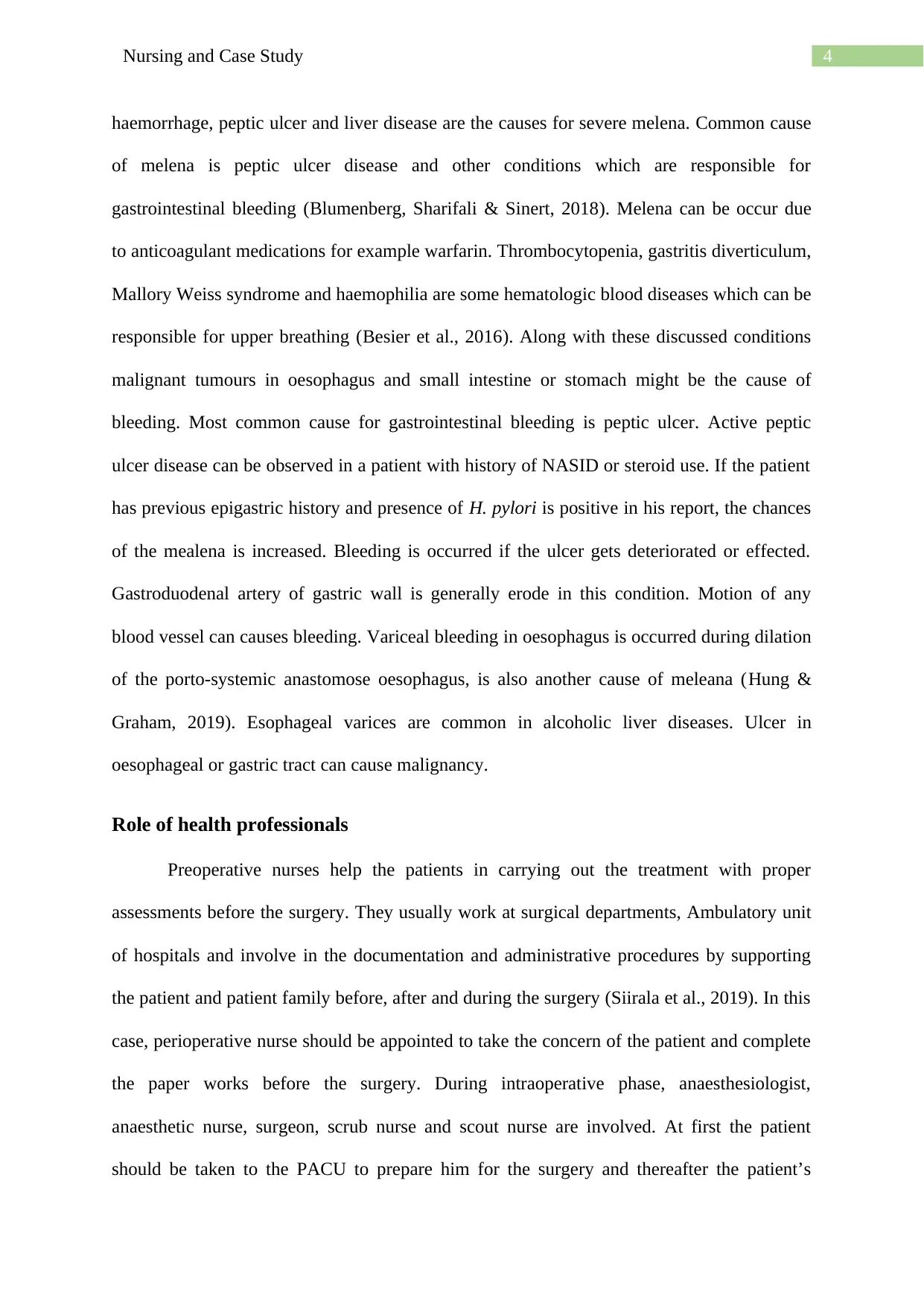
4Nursing and Case Study
haemorrhage, peptic ulcer and liver disease are the causes for severe melena. Common cause
of melena is peptic ulcer disease and other conditions which are responsible for
gastrointestinal bleeding (Blumenberg, Sharifali & Sinert, 2018). Melena can be occur due
to anticoagulant medications for example warfarin. Thrombocytopenia, gastritis diverticulum,
Mallory Weiss syndrome and haemophilia are some hematologic blood diseases which can be
responsible for upper breathing (Besier et al., 2016). Along with these discussed conditions
malignant tumours in oesophagus and small intestine or stomach might be the cause of
bleeding. Most common cause for gastrointestinal bleeding is peptic ulcer. Active peptic
ulcer disease can be observed in a patient with history of NASID or steroid use. If the patient
has previous epigastric history and presence of H. pylori is positive in his report, the chances
of the mealena is increased. Bleeding is occurred if the ulcer gets deteriorated or effected.
Gastroduodenal artery of gastric wall is generally erode in this condition. Motion of any
blood vessel can causes bleeding. Variceal bleeding in oesophagus is occurred during dilation
of the porto-systemic anastomose oesophagus, is also another cause of meleana (Hung &
Graham, 2019). Esophageal varices are common in alcoholic liver diseases. Ulcer in
oesophageal or gastric tract can cause malignancy.
Role of health professionals
Preoperative nurses help the patients in carrying out the treatment with proper
assessments before the surgery. They usually work at surgical departments, Ambulatory unit
of hospitals and involve in the documentation and administrative procedures by supporting
the patient and patient family before, after and during the surgery (Siirala et al., 2019). In this
case, perioperative nurse should be appointed to take the concern of the patient and complete
the paper works before the surgery. During intraoperative phase, anaesthesiologist,
anaesthetic nurse, surgeon, scrub nurse and scout nurse are involved. At first the patient
should be taken to the PACU to prepare him for the surgery and thereafter the patient’s
haemorrhage, peptic ulcer and liver disease are the causes for severe melena. Common cause
of melena is peptic ulcer disease and other conditions which are responsible for
gastrointestinal bleeding (Blumenberg, Sharifali & Sinert, 2018). Melena can be occur due
to anticoagulant medications for example warfarin. Thrombocytopenia, gastritis diverticulum,
Mallory Weiss syndrome and haemophilia are some hematologic blood diseases which can be
responsible for upper breathing (Besier et al., 2016). Along with these discussed conditions
malignant tumours in oesophagus and small intestine or stomach might be the cause of
bleeding. Most common cause for gastrointestinal bleeding is peptic ulcer. Active peptic
ulcer disease can be observed in a patient with history of NASID or steroid use. If the patient
has previous epigastric history and presence of H. pylori is positive in his report, the chances
of the mealena is increased. Bleeding is occurred if the ulcer gets deteriorated or effected.
Gastroduodenal artery of gastric wall is generally erode in this condition. Motion of any
blood vessel can causes bleeding. Variceal bleeding in oesophagus is occurred during dilation
of the porto-systemic anastomose oesophagus, is also another cause of meleana (Hung &
Graham, 2019). Esophageal varices are common in alcoholic liver diseases. Ulcer in
oesophageal or gastric tract can cause malignancy.
Role of health professionals
Preoperative nurses help the patients in carrying out the treatment with proper
assessments before the surgery. They usually work at surgical departments, Ambulatory unit
of hospitals and involve in the documentation and administrative procedures by supporting
the patient and patient family before, after and during the surgery (Siirala et al., 2019). In this
case, perioperative nurse should be appointed to take the concern of the patient and complete
the paper works before the surgery. During intraoperative phase, anaesthesiologist,
anaesthetic nurse, surgeon, scrub nurse and scout nurse are involved. At first the patient
should be taken to the PACU to prepare him for the surgery and thereafter the patient’s
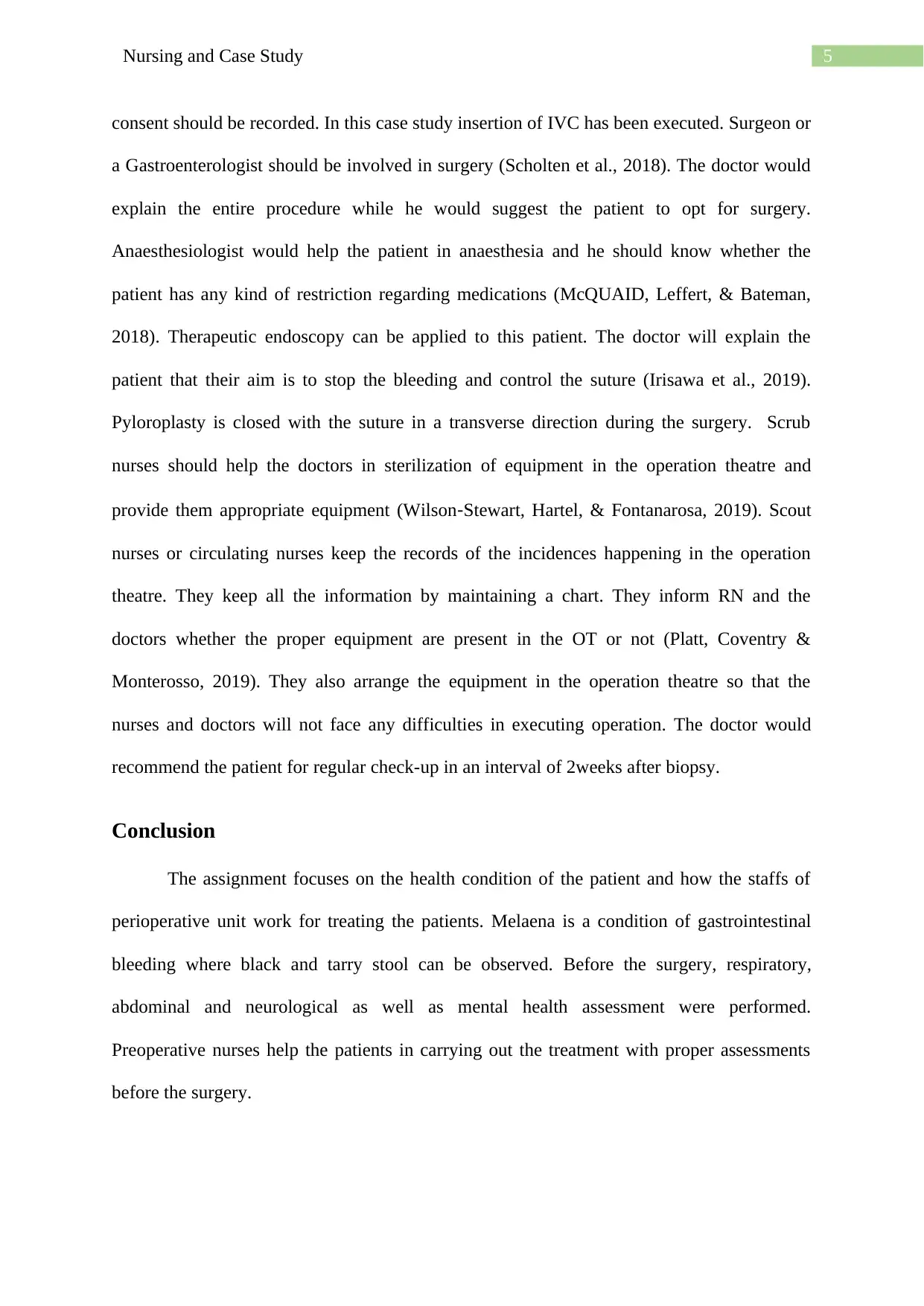
5Nursing and Case Study
consent should be recorded. In this case study insertion of IVC has been executed. Surgeon or
a Gastroenterologist should be involved in surgery (Scholten et al., 2018). The doctor would
explain the entire procedure while he would suggest the patient to opt for surgery.
Anaesthesiologist would help the patient in anaesthesia and he should know whether the
patient has any kind of restriction regarding medications (McQUAID, Leffert, & Bateman,
2018). Therapeutic endoscopy can be applied to this patient. The doctor will explain the
patient that their aim is to stop the bleeding and control the suture (Irisawa et al., 2019).
Pyloroplasty is closed with the suture in a transverse direction during the surgery. Scrub
nurses should help the doctors in sterilization of equipment in the operation theatre and
provide them appropriate equipment (Wilson‐Stewart, Hartel, & Fontanarosa, 2019). Scout
nurses or circulating nurses keep the records of the incidences happening in the operation
theatre. They keep all the information by maintaining a chart. They inform RN and the
doctors whether the proper equipment are present in the OT or not (Platt, Coventry &
Monterosso, 2019). They also arrange the equipment in the operation theatre so that the
nurses and doctors will not face any difficulties in executing operation. The doctor would
recommend the patient for regular check-up in an interval of 2weeks after biopsy.
Conclusion
The assignment focuses on the health condition of the patient and how the staffs of
perioperative unit work for treating the patients. Melaena is a condition of gastrointestinal
bleeding where black and tarry stool can be observed. Before the surgery, respiratory,
abdominal and neurological as well as mental health assessment were performed.
Preoperative nurses help the patients in carrying out the treatment with proper assessments
before the surgery.
consent should be recorded. In this case study insertion of IVC has been executed. Surgeon or
a Gastroenterologist should be involved in surgery (Scholten et al., 2018). The doctor would
explain the entire procedure while he would suggest the patient to opt for surgery.
Anaesthesiologist would help the patient in anaesthesia and he should know whether the
patient has any kind of restriction regarding medications (McQUAID, Leffert, & Bateman,
2018). Therapeutic endoscopy can be applied to this patient. The doctor will explain the
patient that their aim is to stop the bleeding and control the suture (Irisawa et al., 2019).
Pyloroplasty is closed with the suture in a transverse direction during the surgery. Scrub
nurses should help the doctors in sterilization of equipment in the operation theatre and
provide them appropriate equipment (Wilson‐Stewart, Hartel, & Fontanarosa, 2019). Scout
nurses or circulating nurses keep the records of the incidences happening in the operation
theatre. They keep all the information by maintaining a chart. They inform RN and the
doctors whether the proper equipment are present in the OT or not (Platt, Coventry &
Monterosso, 2019). They also arrange the equipment in the operation theatre so that the
nurses and doctors will not face any difficulties in executing operation. The doctor would
recommend the patient for regular check-up in an interval of 2weeks after biopsy.
Conclusion
The assignment focuses on the health condition of the patient and how the staffs of
perioperative unit work for treating the patients. Melaena is a condition of gastrointestinal
bleeding where black and tarry stool can be observed. Before the surgery, respiratory,
abdominal and neurological as well as mental health assessment were performed.
Preoperative nurses help the patients in carrying out the treatment with proper assessments
before the surgery.
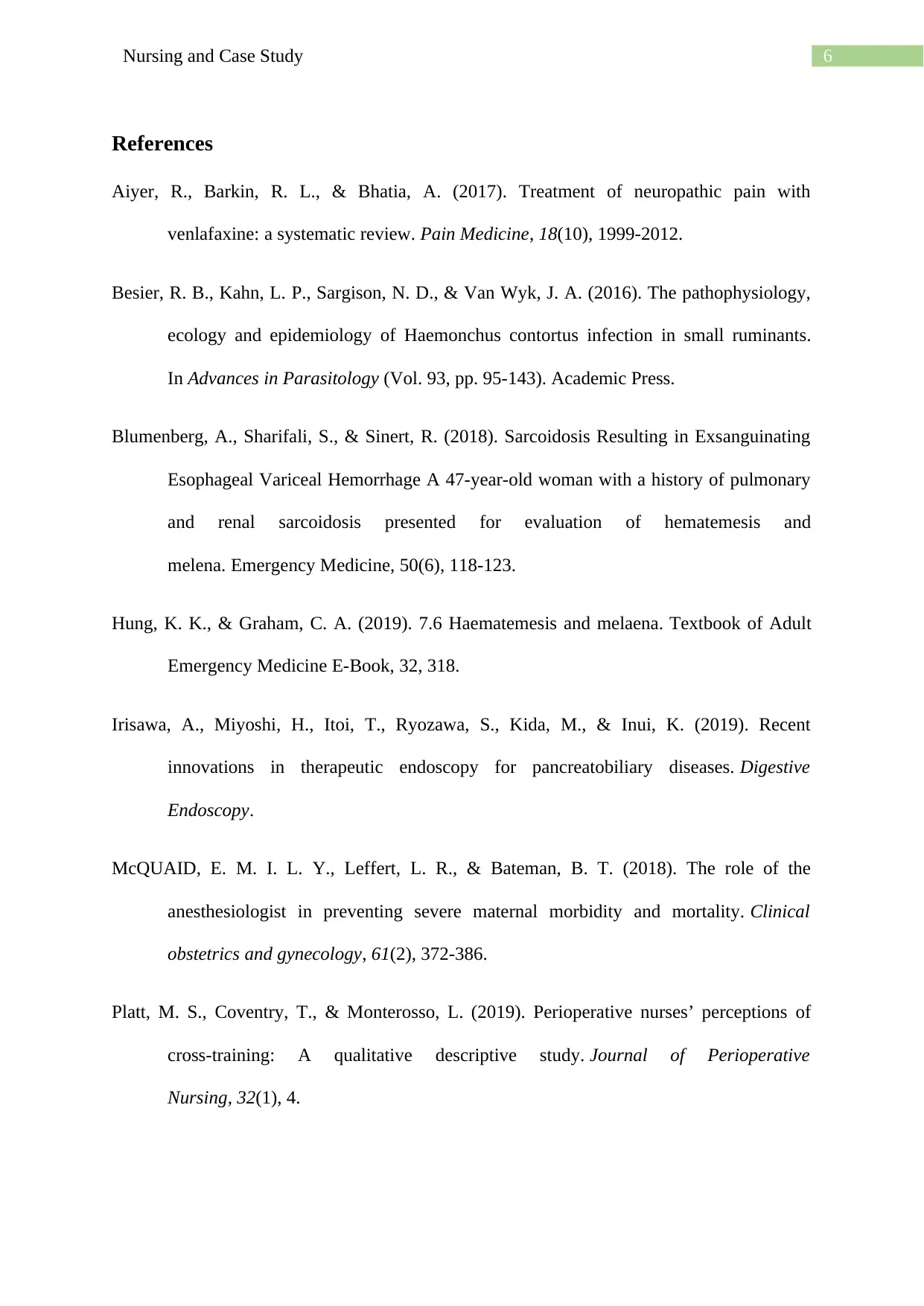
6Nursing and Case Study
References
Aiyer, R., Barkin, R. L., & Bhatia, A. (2017). Treatment of neuropathic pain with
venlafaxine: a systematic review. Pain Medicine, 18(10), 1999-2012.
Besier, R. B., Kahn, L. P., Sargison, N. D., & Van Wyk, J. A. (2016). The pathophysiology,
ecology and epidemiology of Haemonchus contortus infection in small ruminants.
In Advances in Parasitology (Vol. 93, pp. 95-143). Academic Press.
Blumenberg, A., Sharifali, S., & Sinert, R. (2018). Sarcoidosis Resulting in Exsanguinating
Esophageal Variceal Hemorrhage A 47-year-old woman with a history of pulmonary
and renal sarcoidosis presented for evaluation of hematemesis and
melena. Emergency Medicine, 50(6), 118-123.
Hung, K. K., & Graham, C. A. (2019). 7.6 Haematemesis and melaena. Textbook of Adult
Emergency Medicine E-Book, 32, 318.
Irisawa, A., Miyoshi, H., Itoi, T., Ryozawa, S., Kida, M., & Inui, K. (2019). Recent
innovations in therapeutic endoscopy for pancreatobiliary diseases. Digestive
Endoscopy.
McQUAID, E. M. I. L. Y., Leffert, L. R., & Bateman, B. T. (2018). The role of the
anesthesiologist in preventing severe maternal morbidity and mortality. Clinical
obstetrics and gynecology, 61(2), 372-386.
Platt, M. S., Coventry, T., & Monterosso, L. (2019). Perioperative nurses’ perceptions of
cross-training: A qualitative descriptive study. Journal of Perioperative
Nursing, 32(1), 4.
References
Aiyer, R., Barkin, R. L., & Bhatia, A. (2017). Treatment of neuropathic pain with
venlafaxine: a systematic review. Pain Medicine, 18(10), 1999-2012.
Besier, R. B., Kahn, L. P., Sargison, N. D., & Van Wyk, J. A. (2016). The pathophysiology,
ecology and epidemiology of Haemonchus contortus infection in small ruminants.
In Advances in Parasitology (Vol. 93, pp. 95-143). Academic Press.
Blumenberg, A., Sharifali, S., & Sinert, R. (2018). Sarcoidosis Resulting in Exsanguinating
Esophageal Variceal Hemorrhage A 47-year-old woman with a history of pulmonary
and renal sarcoidosis presented for evaluation of hematemesis and
melena. Emergency Medicine, 50(6), 118-123.
Hung, K. K., & Graham, C. A. (2019). 7.6 Haematemesis and melaena. Textbook of Adult
Emergency Medicine E-Book, 32, 318.
Irisawa, A., Miyoshi, H., Itoi, T., Ryozawa, S., Kida, M., & Inui, K. (2019). Recent
innovations in therapeutic endoscopy for pancreatobiliary diseases. Digestive
Endoscopy.
McQUAID, E. M. I. L. Y., Leffert, L. R., & Bateman, B. T. (2018). The role of the
anesthesiologist in preventing severe maternal morbidity and mortality. Clinical
obstetrics and gynecology, 61(2), 372-386.
Platt, M. S., Coventry, T., & Monterosso, L. (2019). Perioperative nurses’ perceptions of
cross-training: A qualitative descriptive study. Journal of Perioperative
Nursing, 32(1), 4.
Paraphrase This Document
Need a fresh take? Get an instant paraphrase of this document with our AI Paraphraser
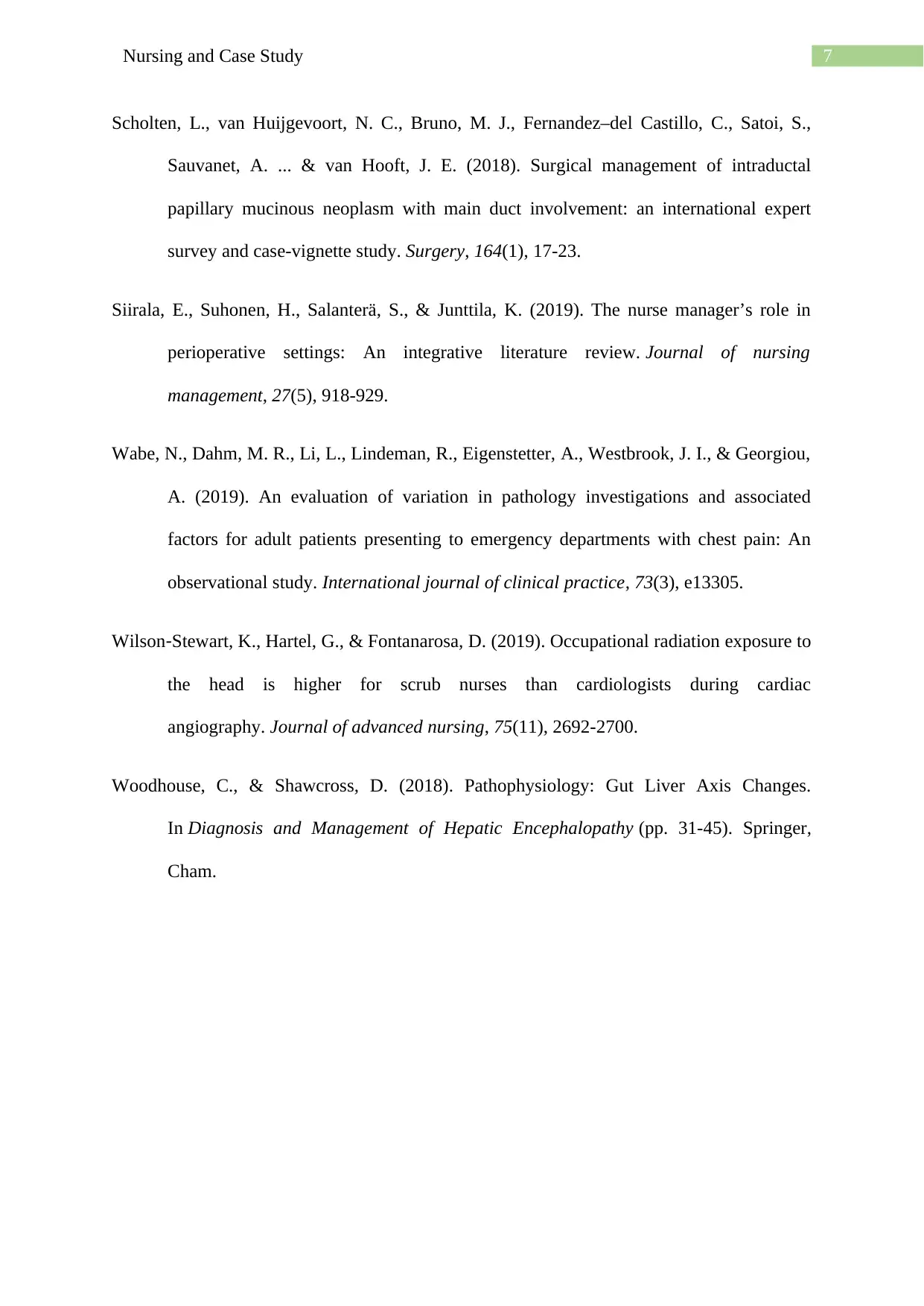
7Nursing and Case Study
Scholten, L., van Huijgevoort, N. C., Bruno, M. J., Fernandez–del Castillo, C., Satoi, S.,
Sauvanet, A. ... & van Hooft, J. E. (2018). Surgical management of intraductal
papillary mucinous neoplasm with main duct involvement: an international expert
survey and case-vignette study. Surgery, 164(1), 17-23.
Siirala, E., Suhonen, H., Salanterä, S., & Junttila, K. (2019). The nurse manager’s role in
perioperative settings: An integrative literature review. Journal of nursing
management, 27(5), 918-929.
Wabe, N., Dahm, M. R., Li, L., Lindeman, R., Eigenstetter, A., Westbrook, J. I., & Georgiou,
A. (2019). An evaluation of variation in pathology investigations and associated
factors for adult patients presenting to emergency departments with chest pain: An
observational study. International journal of clinical practice, 73(3), e13305.
Wilson‐Stewart, K., Hartel, G., & Fontanarosa, D. (2019). Occupational radiation exposure to
the head is higher for scrub nurses than cardiologists during cardiac
angiography. Journal of advanced nursing, 75(11), 2692-2700.
Woodhouse, C., & Shawcross, D. (2018). Pathophysiology: Gut Liver Axis Changes.
In Diagnosis and Management of Hepatic Encephalopathy (pp. 31-45). Springer,
Cham.
Scholten, L., van Huijgevoort, N. C., Bruno, M. J., Fernandez–del Castillo, C., Satoi, S.,
Sauvanet, A. ... & van Hooft, J. E. (2018). Surgical management of intraductal
papillary mucinous neoplasm with main duct involvement: an international expert
survey and case-vignette study. Surgery, 164(1), 17-23.
Siirala, E., Suhonen, H., Salanterä, S., & Junttila, K. (2019). The nurse manager’s role in
perioperative settings: An integrative literature review. Journal of nursing
management, 27(5), 918-929.
Wabe, N., Dahm, M. R., Li, L., Lindeman, R., Eigenstetter, A., Westbrook, J. I., & Georgiou,
A. (2019). An evaluation of variation in pathology investigations and associated
factors for adult patients presenting to emergency departments with chest pain: An
observational study. International journal of clinical practice, 73(3), e13305.
Wilson‐Stewart, K., Hartel, G., & Fontanarosa, D. (2019). Occupational radiation exposure to
the head is higher for scrub nurses than cardiologists during cardiac
angiography. Journal of advanced nursing, 75(11), 2692-2700.
Woodhouse, C., & Shawcross, D. (2018). Pathophysiology: Gut Liver Axis Changes.
In Diagnosis and Management of Hepatic Encephalopathy (pp. 31-45). Springer,
Cham.
1 out of 8
Related Documents
Your All-in-One AI-Powered Toolkit for Academic Success.
+13062052269
info@desklib.com
Available 24*7 on WhatsApp / Email
![[object Object]](/_next/static/media/star-bottom.7253800d.svg)
Unlock your academic potential
© 2024 | Zucol Services PVT LTD | All rights reserved.





